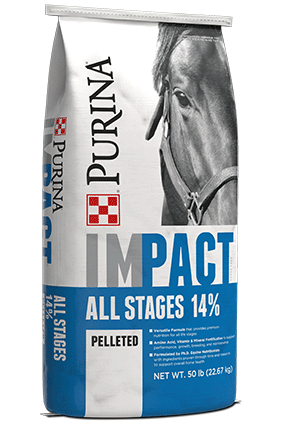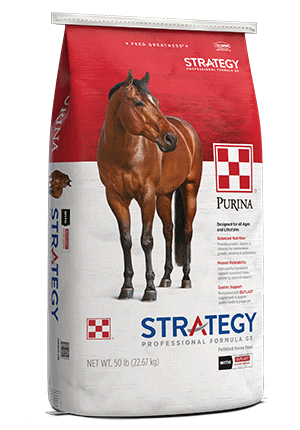
Improving Gut Health with Equine Feed Additives
Nutrition : Ingredients & Nutrients
Care : Health Issues
Purina Animal Nutrition has a strong commitment to research that explores feed additives such as prebiotics, probiotics, “gut soothers” and the like.
We believe that in the future, these additives have great potential to be an important part of good nutrition for horses, especially as we get to know more about the collective microbial population in the equine hindgut.In the meantime, we remain active in our research and observance of these products’ performance in the industry.Unfortunately, if someone asked us today what gut additive they should feed to their horse, we would not have a good answer for them.
Here are the reasons.
Direct fed microbials (DFMs/probiotics) are designed to provide live colonies of lactic acid and other bacteria for optimal gut or animal health. However, the issue of whether or not the DFMs reach the hindgut in a viable state must first be addressed. In a study attempting to confirm product viability, only 2 of 13 commercially-available DFM products tested met label claims (Weese 2002). More recently, research also demonstrated no benefit of DFMs on gastrointestinal microflora, cortisol response to transport stress, or antibody response (Saul, 2012).Further, the author of this study communicated that multiple commercial products claiming to have live cultures were found to be sterile upon testing.Therefore, work must be done and validated to ensure that products contain the live colonies claimed on labels. Once a viable organism is found, questions need to be answered around both the proper inclusion rate in a feed and the organism’s survival during storage and manufacturing processes. If the product passes this test, in vitro and in vivo experiments would be necessary to determine efficacy and mechanisms of action. To date, there are very limited studies in horses that clearly show colonization and health benefit, and in fact, administration of a probiotic to foals increased incidence of diarrhea and colic compared to placebo (Weese 2005).Therefore, much more work is necessary in the DFM field before we can recommend these with confidence in horses.
In terms of data available for prebiotics, such as yeast, Purina recently conducted multiple in-depth digestibility studies that demonstrated no benefit in apparent digestibility of DM, ADF or NDF from the inclusion of yeast culture in the diet of mature horses (Gordon and Edwards, 2013 a,b).These results agree with the work reported by Hall, (1990); Markey, (2006) and Webb, (1985) who reported no significant differences of apparent digestibility of nutrients by mature horses, 3 year olds, or yearlings, respectively. Conversely, a series of experiments performed by Glade (1986, 1990, 1991) suggested some benefits of yeast supplementation, including increased rate of gain in foals and improved fiber digestibility when fed individual feedstuffs such as oats and hay.Jouany et al. (2008) demonstrated increases in fiber enzymes when yeast is fed along with straw. However, when we test prebiotics along with feedstuffs that are high quality and manufactured to enhance digestibility (such as those made by Purina), there is no further benefit of adding yeast culture.Therefore, our choice to not include them at this time is multi-factorial, but stems around current data, cost and need.
Another point to make is how research can sometimes be used to justify inclusion, but may not actually tell the full story. Several companies cite the work of Medina (2002) that demonstrated a decrease in hindgut acidosis of horses fed very high starch diets supplemented with S. cerevisiae.It is important to point out that the high starch diet in this study was fed at a rate of 3.4g starch/kg BW, which is within the established upper limit for starch overload of ~2.0-4.0g starch/kg BW (NRC, 2007). To reach this high level of starch, a horse would need to eat approximately 12 lbs of Purina® Omolene® #200 feed in one meal, which is at least twice the recommended feeding rate. One could also argue that feeding yeast culture to help a horse that is intentionally fed an excessive level of starch is simply not a good solution. Changing other nutritional or management factors, such as feeding a feed higher in fat/fiber and lower in starch and/or feeding smaller meals, would be of more benefit to the horse in terms of addressing the risk of hindgut acidosis. Further, a recent abstract by Coverdale et al. (2013) showed no statistically significant benefit to adding yeast culture to equine diets for DM, ADF or NDF digestibility. Despite the authors’ conclusion claiming increased digestibility, the statistics do not support this statement with a corresponding P value of P = 0.13. Therefore, due to the conflict in reported data on the efficacy of yeast culture, and other nutrition and management factors that may be more beneficial to the horse (i.e., feeding more digestible or different feedstuffs to begin with), we do not include yeast culture in our feeds at this time.
As it pertains to gut additives, when we find a product that meets our criteria for efficacy and benefit to the horse, as opposed to simply creating an interesting marketing story, it will be incorporated into our feeding programs. We hope that future research will address the following issues for pre- and probiotics: 1) viability and mechanism of action in the gut to produce the desired effect; 2) data to show stability in a plant environment and manufacturing system such as pelleting/extrusion; 3) benefit, safety, efficacy, and dosage studies in horses that show an advantage to supplementation over and above current beneficial feeding practices.
In conclusion, current practices of feeding high quality feedstuffs in appropriate amounts, along with good nutritional management can help horses to maintain a healthy gastrointestinal environment. As we continue our research, you can be confident that if and when we find an additive that helps horses to digest, absorb and assimilate nutrients, we will bring it to you in our lineup of products.





